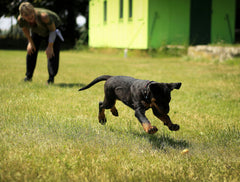
If you are adopting a new puppy or dog, one of the things that you might want to do is weigh your dog often. Whether you just want to see how much your dog is growing or you want to figure out how big a certain dog will be when they get older, a puppy growth chart or dog weight calculator can help a lot.
You can even use a food calculator to see how much food your puppy or dog should be getting and how much they should weigh. Keep reading here to find out more about a dog’s growth, how to properly use a dog weight calculator, and how to use a dog size chart.
Factors for Puppy Growth

You might be wondering how big your puppy is going to get. You might also want to know when your puppy will be fully-grown. These answers can vary based on many factors.
When puppies stop growing, generally, the larger dog breeds don’t reach their full growth until they are between 18 to 24 months. However, the smallest dog breeds can reach their full growth by around 6 months old.
The factors that can influence how big your puppy is going to get are the following:
- Desexing age - If you have your dog spayed or neutered earlier in their life it can interfere with the way that certain chemicals communicate with the bones. This means that the earlier a dog is neutered, the taller they are likely to get.
- Gender - Generally, female dogs are going to be smaller than male dogs.
- Breed of dog - There are tiny, small, medium, and large dog breeds. There are dog breeds that fall into the middle of these categories, as well. The tiny dog breeds such as the chihuahua can be as little as 6 pounds while the largest dog breeds can be as much as 300 pounds.
Hopefully, this information will help you to determine how big the dog you have now will be on average. You can also use the size of the mother and the father to estimate how big your puppy will be when they are fully-grown.
If you want even more information on predicting your dog’s size when they are fully-grown, there are some tools and methods that you can use.
Gaining Per Week

One of the first rules is that a puppy will gain about 5 to 10% of their birth weight every day until they are 6 weeks old. At that point, their weight gain is different based on the size of their breed.
For example, smaller dog breeds will gain about 5 ounces every week until they are fully grown. Larger dog breeds will gain nearly 2.5 pounds every week until they are fully grown.
Weight Divided by Age

Did you get your puppy when they were older? If so, there is another way you can figure out how big your dog is going to be when they are fully grown. You will take their weight and divide it by their age. For example, say your puppy is 40 pounds and 16 weeks old.
You will take 40 and divide it by 16. This equals 2.5. Then, you are going to take the 2.5 and multiply it by 52 (this is the total weeks in 1 year). In this example, the adult weight would be about 130 pounds. This should give you a good idea of what your dog will weigh when they are fully grown.
Using a Puppy Growth Chart Calculator

There is another way that you can determine how big your dog is going to be when they are fully grown. You can use a puppy growth chart calculator. If you are going to use this dog size chart calculator the best times to use this are the following:
- 12 weeks old for smaller dog breeds
- 16 weeks old for medium dog breeds
- 20 weeks old for larger dog breeds
If you use the calculator at these times, you will get the most accurate estimation of what your dog will weigh when they are fully grown. However, you can still use it when your dog is of different ages.
There are also puppy growth chart calculators you can use that allow you to input your dog’s current weight, age, and breed. This can give you an estimate of how big your dog will get, as well.
Conclusion
Now you know more about how to properly use a dog weight calculator. You can also use a food calculator to determine how much your dog should be eating to gain the appropriate amount of weight. If you have more questions about how big your dog is going to get, it would be best to talk to your dog’s veterinarian. They will have your dog’s history, their specific breed, current weight, and age. From there, they can track your dog’s weight and give you a better idea of how much your dog will likely gain.




